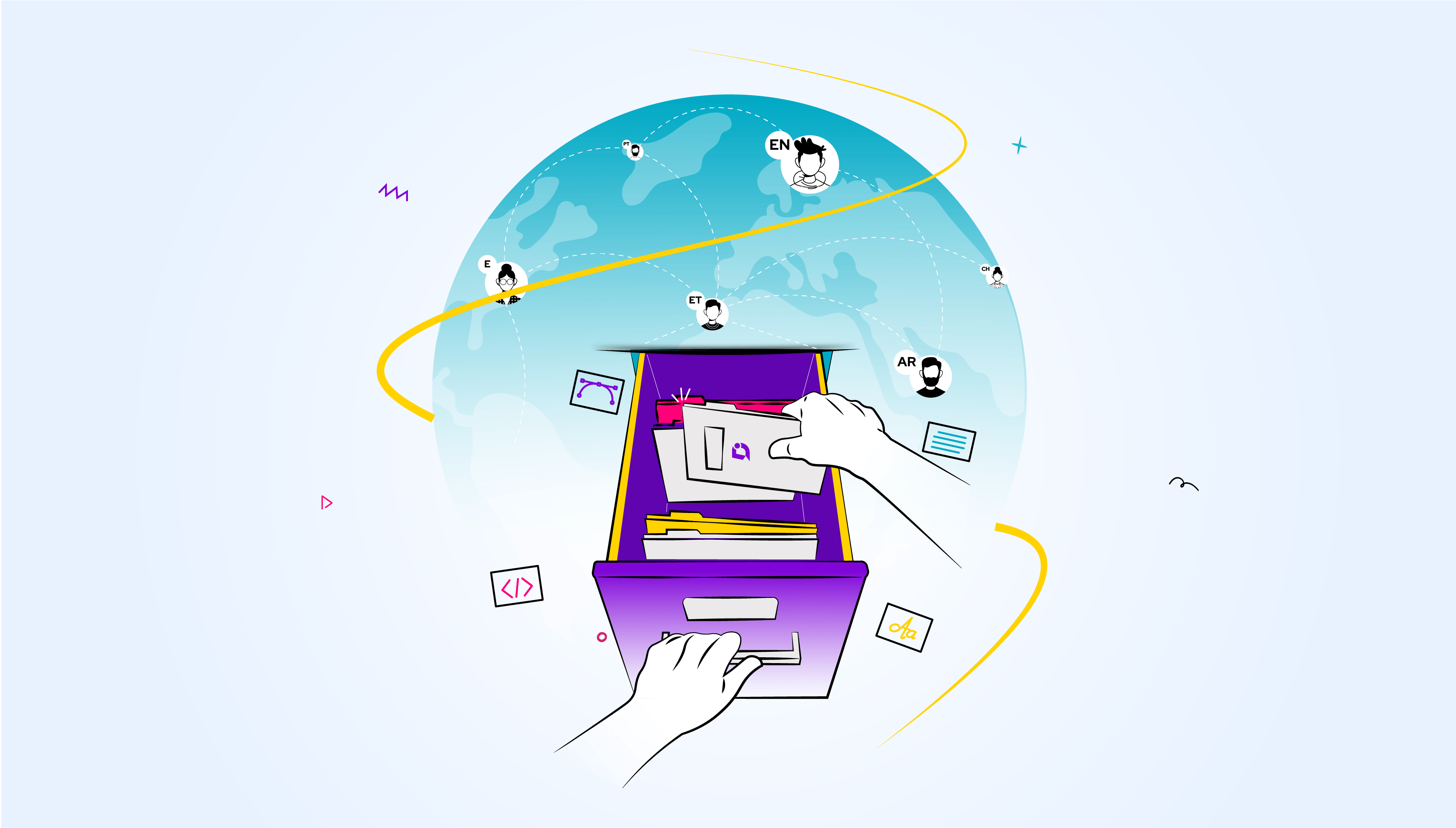Document localization allows companies to connect seamlessly with global audiences and build meaningful relationships.
What is Document Localization?
Document localization is a part of documentation when an interpreter translates the document and tailors it to suit a specific target audience’s linguistic, cultural, and regional preferences.
You need more than translating your document to different languages; you must make it clear to readers of different cultural and local nuances. With localization, you can customize content and messaging – product descriptions, marketing materials, user guides, and support documentation – to align with the target audience’s language and culture.
Differences between Localization and Translation
Localization and translation are often used interchangeably, but they differ. While translation focuses solely on converting content from one language to another, localization goes beyond language to encompass cultural and regional considerations.
|
Aspect |
Localization | Translation |
|
Definition |
Adaptation of content to suit the specific cultural context |
Converts written content from one language to another |
|
Scope |
Extends beyond language to include cultural elements |
Focuses solely on linguistic conversion |
|
Target Audience |
Tailored for a specific regional audience |
Primarily aimed at speakers of a different language |
|
Process |
Requires cultural research and context understanding |
Focuses on linguistic accuracy and grammar |
|
Changes |
This may involve modifying visuals, symbols, and formats |
Limited to textual changes only |
|
Content Types |
Applied to websites, marketing, and UI/UX |
Commonly used for documents, books, and articles |
|
Complexity |
More intricate and time-consuming process |
Generally quicker and less complex |
|
Purpose |
Aims to adapt content to resonate with local audiences and preferences |
Aims to convey the same message in another language |
Understanding these fundamental differences is crucial in recognizing the unique role each process plays in adapting content for global audiences.
Why does localization matter?
Tailoring content to suit specific locales allows businesses to create genuine connections with their audiences, leading to better user experiences and stronger customer loyalty.
Businesses that invest in document localization gain a competitive edge. Why? They can navigate diverse markets and establish a robust international presence effectively. Understanding document localization’s real-life applications and benefits help businesses seize opportunities for growth and success in the global marketplace.
Benefits of document localization
-
- Increased reach and user engagement: Document localization allows businesses to connect with a broader audience across different regions and cultures. Speaking directly to the local audience in their language helps companies to expand their reach and foster stronger user engagement.
- Improved user understanding and adoption: Localized documents are easier to comprehend as they are presented in a familiar language. This enhanced understanding leads to quicker adoption of products or services, resulting in a more satisfied customer base.
- Enhanced brand reputation and credibility: When businesses invest in document localization, it demonstrates a commitment to providing personalized experiences for their customers. Doing this enhances brand reputation and credibility in the eyes of the global audience.
- Increased sales and revenue: Localization is deeper than translating your content to another language, it’s about forging deep connections with your target audience – understanding their unique preferences, and tailoring your offerings to fit their needs. Doing this will help you increase sales because customers buy more when they feel understood.
- Support and customer satisfaction: Localized support documentation and user guides help customers easily navigate products or services.
- A better understanding of compliance with legal and regulatory requirements: Localizing documents allows businesses to effectively communicate compliance information to customers in different regions.
- Competitive Advantage: Companies that invest in document localization gain a competitive edge in the global market. By offering content that resonates with local audiences, they can outperform competitors who provide content only in one language.
- Cost Efficiency in the Long Run: While document localization involves an initial investment, the long-term benefits outweigh the costs. Reduced customer support, higher sales, and improved brand reputation lead to cost efficiencies in the long run.
Schedule a demo with one of our experts to take a deeper dive into Document360
Book A Demo
Steps for the document localization process
Here are the essential steps to ensure a successful document localization:
Step 1: Determine Your Localization Strategy
Define the target languages and regions for localization based on market research and customer data. Set specific goals and objectives for the localization process to align with your business expansion plans.
Step 2: Pull in Content Localization Team
Collaborate with a team of translators, language experts, and cultural consultants to develop a detailed plan for each localized document version.
Step 3: Extract the Resource File
Extract the content from the source document and create a sharable resource file. This file should preserve the document’s formatting and structure for a smooth translation process.
Step 4: Choose a Translation Tool
Select a suitable translation tool or localization software to streamline the translation process. Advanced tools like Computer-Assisted Translation (CAT) tools can assist in maintaining consistency and efficiency.
Step 5: Translate the Content
Begin the translation process by having the content localized into the target languages. Professional translators will adapt the text while considering cultural nuances, idiomatic expressions, and regional preferences.
Step 6: Review the Translated Content
Perform a comprehensive review of the translated content to ensure accuracy, consistency, and adherence to the localization strategy. This step involves proofreading and editing to refine the quality of the localized documents.
Step 7: Ensure Quality Assurance
Conduct quality assurance checks to verify that the localized content meets the required standards. Test the documents in their intended context and format to identify potential issues.
Step 8: Publish the Content
Once the localized documents have passed quality assurance, it’s time to publish them for the target audiences. Make the necessary updates to your website, user manuals, marketing materials, and other relevant platforms.
Following the document localization steps above will result in content that resonates with local audiences, drives engagement, and contributes to the overall success of your business expansion efforts.
Best Practices for Successful Documentation Localization
Document localization requires a thoughtful approach to connect with diverse regional audiences effectively. Here are some best practices to ensure a seamless and successful documentation localization process:
Formatting and Layout Considerations
Pay attention to the layout and formatting of the localized document to maintain visual consistency. Ensure that translated text fits appropriately within the design, and be mindful of variations in text length between languages. Consider languages that read right-to-left and accommodate these changes accordingly.
Adapting Language and Tone
Tailor the content’s language and tone to suit the target audience’s cultural preferences and sensibilities. Adapt idiomatic expressions, metaphors, and colloquialisms to resonate with the local language while maintaining the original message’s intent.
Addressing Cultural Nuances
Understand the cultural norms, practices, and taboos of the target region. It’s not a secret that words mean different things in different cultures. For instance, “Nega” means “You” in Korean, but it’s offensive in other cultures because it means something else.
Localizing Images, Videos, and Examples
Localization extends beyond text. Images, videos, and examples should also be localized to align with the target audience’s cultural context. Replace images or videos that may not be culturally relevant and ensure the examples relate to the local audience.
Ensuring Accuracy and Consistency
Consistency is key in documentation localization. Use approved glossaries, style guides, and translation memories to maintain a uniform tone and vocabulary across all translated documents. Regularly update these resources to ensure accuracy and avoid discrepancies.
Collaboration with Localization Experts
Collaborate closely with experienced localization experts, including translators, cultural consultants, and native speakers. Their expertise ensures that the localized content effectively communicates with the target audience and respects cultural norms.
Proofreading for Quality Assurance
Thoroughly proofread and review the localized content for quality assurance. Identify and resolve any issues encountered during the localization process. Engage both in-house and external experts for an unbiased evaluation.
By implementing these best practices, businesses can achieve successful documentation localization. Careful attention to formatting, language, cultural nuances, and visuals fosters a solid and authentic connection with diverse audiences, ultimately enhancing the global impact of the content.
Check out How to Create Multilingual Knowledge Base with Document360:
Implementing Localization Tools
When efficiently implementing document localization, leveraging advanced localization tools can significantly streamline the process. One tool worth mentioning is Document360.
Document360 is a powerful knowledge management platform designed to facilitate content creation, management, and localization. While it is primarily known for its multilingual documentation capabilities, it also offers robust features to support document localization.
Key Features of Document360 for Localization:
Multilingual Documentation: Document360 provides a seamless environment to create and manage multilingual documentation. Teams can efficiently maintain content in different languages and easily switch between them to make updates.
Collaboration and Workflow Management: It enables smooth collaboration among content localization teams. Assign specific roles and permissions to collaborators based on language expertise, making it easy to manage workflows.
Version Control and Tracking: Document360 offers version control features, ensuring that all localized documents are up-to-date. Translators can effortlessly manage translation tasks and track changes, maintaining consistency across versions.
User Interface Localization: Effortlessly translate the user interface text, such as buttons and labels, with Document360’s user-friendly interface. This feature simplifies adapting the software or platform for different language audiences.
SEO Localization: Optimize your content for local search terms and improve discoverability in various regions. Document360 supports SEO practices that enhance your content’s visibility in local search results.
Automated Sync with Crowdin: Document360 offers Crowdin integration, a popular localization software. This automated synchronization allows seamless content transfer between the platforms, streamlining the translation workflow.
Knowledge Base and Self-Service Support: Its knowledge base functionality allows businesses to create comprehensive support documentation in multiple languages. This enables users to access self-service support in their native language, enhancing customer satisfaction.
Conclusion
Document localization is a game-changer for businesses venturing into the global market. When you tailor your content to connect with diverse regions and cultures, the impact is remarkable – your reach expands, audiences engage with enthusiasm, and your brand reputation soars worldwide.
Embracing industry best practices and leveraging advanced localization tools like Document360 enhances the effectiveness of the process, leading to increased user engagement, improved customer understanding, heightened brand credibility, and a competitive advantage in the global landscape.




 –
– 

